Bulkhead Inspections
Bulkhead Inspections
Symptoms of a Failing Bulkhead
Did you know that a single bulkhead failure could have a devastating impact on your home? The smallest fault in your bulkhead could result in soil being pulled into the water, causing erosion and property loss. After years of corrosion, deterioration and undermining, there is no way of knowing what your bulkhead looks like under the surface.
Here are just a few symptoms that your bulkhead might be at risk of failure:
- Corrosion/Rust
- Cracks
- Loss of fill
- Low spots or depressions in the yard/deck
- Undermining
- Leaning or sagging bulkheads
If you notice any of these symptoms on your property, be sure to contact us immediately for a quote, to be sure that your bulkhead is not at risk of failure.
Our Solution
With over 25 years of experience, our certified engineers and divers can inspect your bulkhead to see if your property is at risk. Not only can we inspect your bulkhead, but we also have our own engineering and construction teams who can help to create a rehabilitation plan in the event that your bulkhead is at risk for failure.
The Castle Group performs:
- Bulkhead inspections
- Existing bulkhead repairs
- New bulkhead design and installation
We have a wide range of innovative bulkhead designs using steel, timber, concrete or composite materials. Whether you are the owner of a waterfront property or you need engineering and design services for a large-scale public project, The Castle Group can perform an inspection and/or develop a repair plan to meet your specific requirements.
To find out more about The Castle Group’s experience with inspecting, repairing, and installing marine bulkheads, check out the projects below.
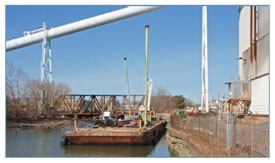
Privately Owned Corporation Facilities
Bulkhead Design
> READ MORE
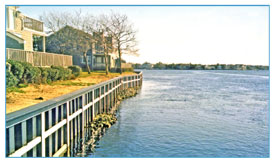
Bay Point Harbour
Bulkhead Design & Construction
> READ MORE
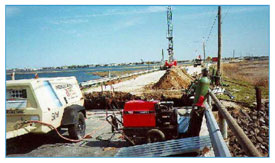
Margate City Bulkhead Reconstruction
> READ MORE
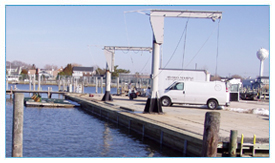
Bay Head Yacht Club Bulkhead Design/Build
> READ MORE
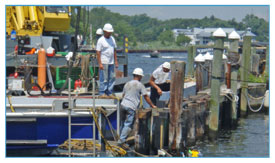
Point Pleasant Bulkhead Design & Build
> READ MORE
FAQs
While bulkheads and seawalls both retain soil and help to prevent the erosion of the land behind them, the main difference between these two structures is their ability to provide protection from waves. Although bulkheads can provide minimal protection from waves, this is not their main function. Seawalls are designed to be used on beaches where wave activity is high. Bulkheads are more commonly found in bays, marinas, ports, rivers and lakes.
There is no right answer to this question. The choice of materials used in bulkhead construction depends entirely on the conditions of the marine environment. Materials used for bulkhead construction include concrete, steel, aluminum, timber and vinyl. We recommend consulting with a licensed engineer before deciding which material will be used for your bulkhead.
We recommend having your bulkhead inspected every 3 to 5 years. It’s better to inspect and repair your bulkhead now, than to deal with it when it’s too late. Over the long run, the cost of preventative maintenance is much cheaper than the costs to repair a collapsed bulkhead.
Depending on the extent of damage to your bulkhead, it is possible to make simple repairs, thus extending the life of your existing bulkhead and preventing the costly expenses of demolishing and replacing your entire structure.
If you choose to have The Castle Group perform both your inspection and repairs, you can have peace of mind in knowing that the same people who inspected your bulkhead will also be the ones repairing it. The Castle Group is your “one stop shop” for any of your bulkhead needs, as you won’t have to deal with numerous companies and contractors delaying the completion of your project.
At The Castle Group, we believe that even the smallest fault in your bulkhead should be taken seriously. Although faulty sections start small, they only get worse over time. However, if our certified engineers and divers find no damages, we will notify you that no replacements or repairs are necessary at this time.
The Castle Group has over 25 years of experience in performing a wide variety of marine engineering and construction services. This includes structural engineering, hydrographic/fathometric surveys, side scan sonar, pier construction, pile jacking repairs, submarine power cable repairs, underwater debris removal, design/build of customized prefabricated bridges and much more! To find out more about The Castle Group, visit us online at www.wjcastlegroup.com